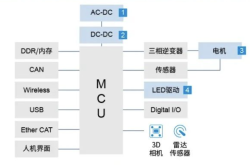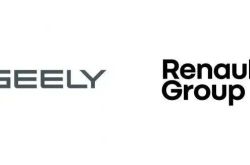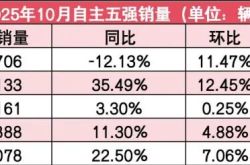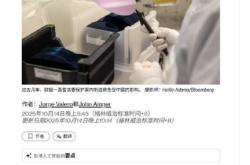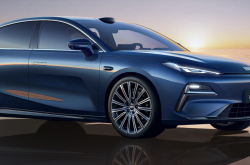Tesla's "Master Plan Phase 4" Roadmap Fully Deconstructed: Energy × FSD × AI × Robotics = ?
![]() 03/24 2025
03/24 2025
![]() 440
440
Musk is exceptionally skilled at dream-building, and importantly, he has realized some of these dreams. This is why many people continue to enter his dreamscape, explaining why Tesla, its products, and its stock price are highly sought after. Recently, Musk publicly released the content of his 2025 Q1 All-Hands Meeting for the first time. During his speech at this meeting, Musk revealed the overall information and vision of his dream's new phase, Master Plan Phase 4.
Of course, Musk has not officially released the Master Plan Phase 4. For those unfamiliar with what the Master Plan is, you can refer to our previous article "Musk's Master Plans - Electric Supercars, Mass-Market EVs, AI Smart Cars, and Robots, What's Next?" for more information.
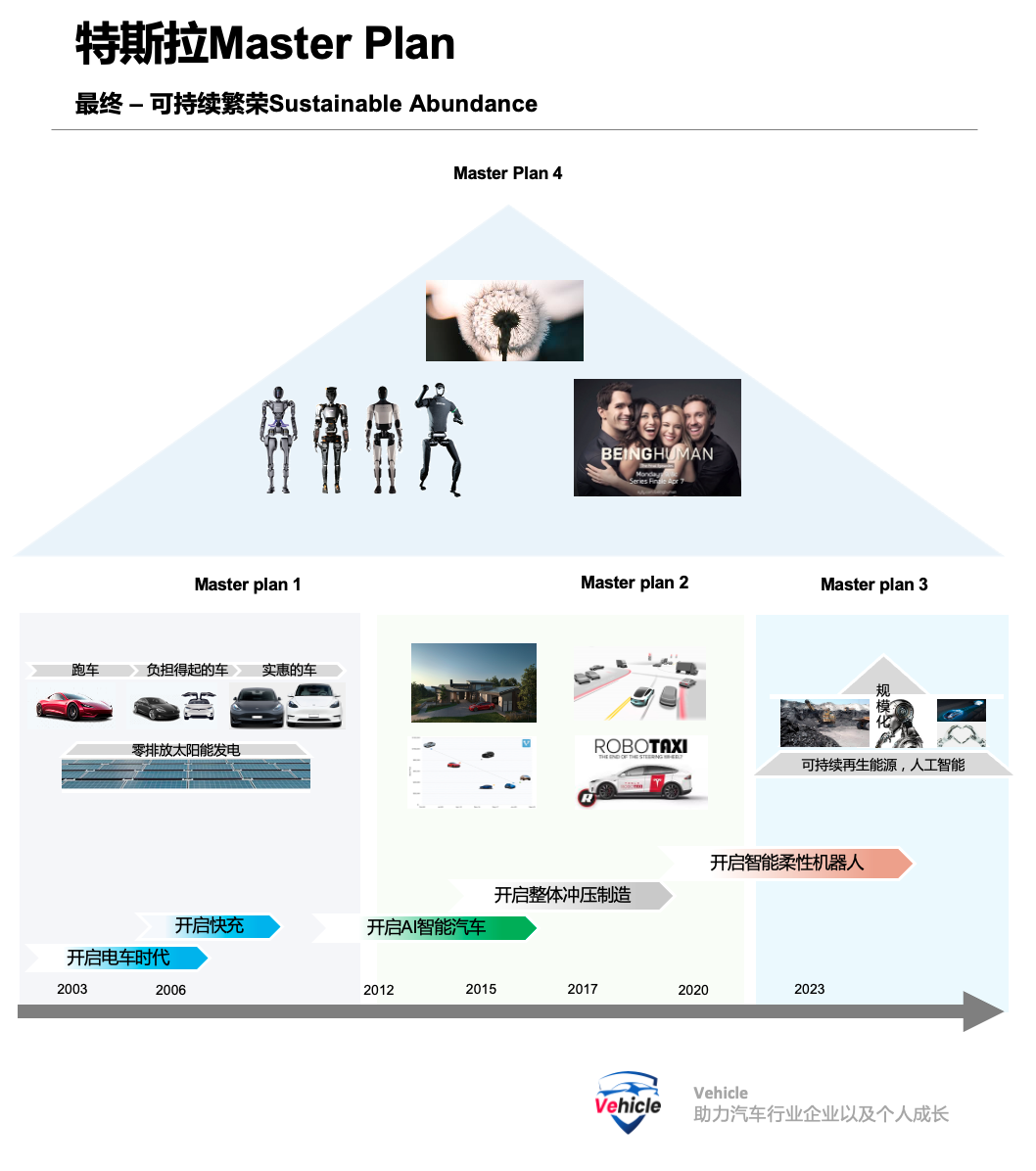
Based on the information revealed during Tesla's 2025 Q1 All-Hands Meeting regarding Master Plan Phase 4, this article organizes the following content:
What is Sustainable Abundance? What technologies are the pillars? How will society be reconstructed? What are the differences from the previous three phases? What are the implementation paths and challenges?
Tesla's Master Plan Phase 4 - Sustainable Abundance is a comprehensive vision that transcends energy and transportation. Its core is to democratize resources through technological integration while maintaining ecological balance. The following is a detailed analysis:
I. What is Sustainable Abundance? Musk's dream of Sustainable Abundance refers to achieving a symbiotic state of infinite resources and zero environmental burden through a combination of renewable energy, artificial intelligence, and robotics, while meeting the material needs of all humanity. Its essence is "allowing everyone to obtain everything they desire without destroying nature." II. Four Technological Pillars. Musk believes that achieving Sustainable Abundance primarily relies on the following four technological pillars, which are also the directions in which Tesla is heavily investing and developing: 1. Energy Democratization, primarily relying on renewable energy sources such as solar energy combined with battery storage to democratize energy.
Solar Energy + Battery Storage form the foundation of the energy network:
For household applications: For example, using Powerwall 3 for energy storage to enable off-grid living and form a distributed virtual power grid.
For industrial and commercial use: Mega Pack doubles the output of existing power grids, enabling nighttime energy storage and fluctuation regulation.
Goal: Over 90% of future household and industrial electricity consumption will come from solar energy and batteries (analogous to satellite energy models).
2. Autonomous Driving Transportation Network, achieved through the implementation of autonomous driving technology.
Fully Self-Driving (FSD) fleets for mobile transportation:
Tesla can simply release the shared economy value of 10 million existing Tesla vehicles through software updates.
Moreover, autonomous driving can increase vehicle utilization efficiency by 5-10 times (from the current 10 hours per week to 80-100 hours in the future).
Impact: This can restructure urban transportation, freeing up an average of 10 hours per week of driving time for new productivity.
3. Humanoid Robots (Optimus), with mature technology entering mass application.
Musk positions humanoid robots as "intelligent household managers + productivity tools":
Their functions cover household chores (cleaning/gardening), education, nursing, flexible manufacturing, and other daily life and industrial scenarios.
Production of 5,000 units in 2025, targeting 50,000 units in 2026, with an ultimate annual production capacity of 100 million units.
Technology Reuse: For Tesla, humanoid robots represent technology reuse, inheriting Tesla's motors, batteries, AI algorithms, and manufacturing capabilities.
The development of humanoid robots is exploding both domestically and internationally, with an economic scale even exceeding that of automobiles by more than tenfold. They represent the future.
4. AI and Supercomputing, primarily technology for computing power facilities, serving as an incubator for intelligence. Tesla's current Cortex One computing center is used for AI training; edge computing power, such as Autopilot hardware, will continue to iterate from HW 4.0 to 7.0. Cortex One Computing Center
Currently, a cluster of 50,000 GPUs, with plans to expand to 100,000 GPUs in the next step, aiming to become one of the top five computing centers globally.
Unified AI architecture supporting autonomous driving and robot learning.
Dojo Supercomputer driving technological iteration:
Dojo 1 currently handles approximately 5% of the autonomous driving AI training load.
Dojo 2 will have a performance increase of 10 times.
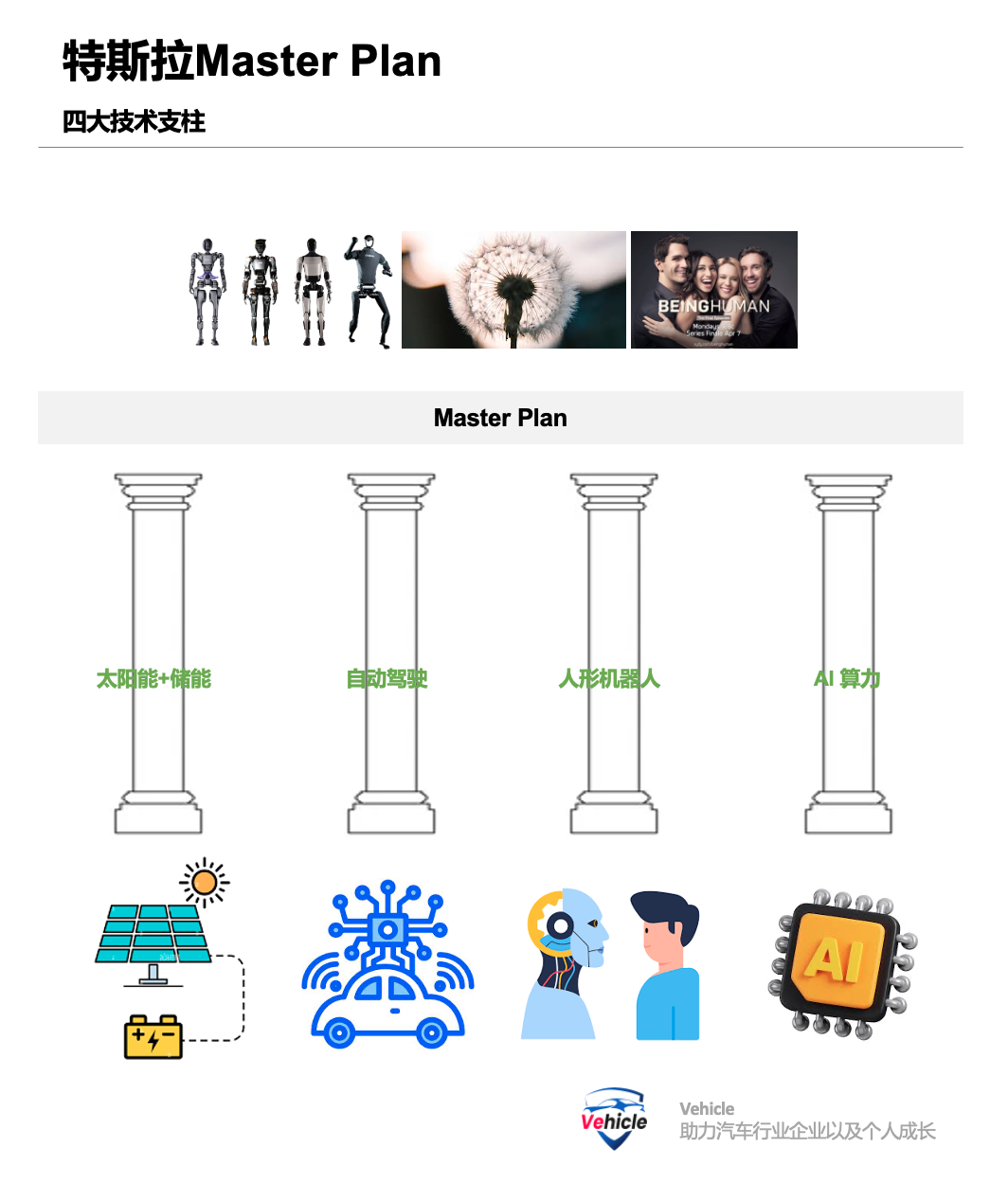
The mass application of the above technologies forms the foundation of Sustainable Abundance.
III. Reconstruction of Social Landscape. Developing along the technical route of Sustainable Abundance will inevitably lead to social reconstruction. From economic models to human-machine relationships, to ecology and lifestyle, there will be entirely new changes. Economic Model Transformation, from "Scarcity Economy" to "Abundance Economy": Robots take on repetitive labor, and humans shift to creative management roles. There is no need to worry about unemployment. For example, during the transportation revolution, vehicles replaced horses. Those who previously raised horses didn't become unemployed; they became car manufacturers, and horse veterinarians became car mechanics. Autonomous driving fleets form shared asset pools, reducing the cost of individual resource ownership.
Evolution of Human-Machine Relationships, not simply unilateral human input and machine output, but rather an interactive and enhanced society:
Neuralink Brain-Machine Interface expanding human capabilities.
Humans and robots form collaborative networks (e.g., managing 10-20 robots).
Dual-Track System of Ecology and Space, Expanding Human Survival Boundaries.
On Earth: Achieving "Negative Carbon Abundance" through renewable energy and efficient manufacturing.
In Space: Combining SpaceX technology to achieve Mars colonization, expanding human survival boundaries.
IV. Differences from the Previous Three Phases. What are the differences between Master Plan Phase 4 and the previous three phases? Phase Core Objective Key Technologies Social Impact Phase 1 Proving the Viability of Electric Vehicles Roadster Battery Technology Revolutionizing the Automotive Industry's Perception Phase 2 Scaling Affordable Electric Vehicles Model 3/Y + Gigafactories Driving the Popularization of Electric Vehicles Phase 3 Fully Sustainable Energy System Solar Roof + Megapack Decentralizing the Energy Industry Phase 4 Post-Scarcity Society with Abundant Resources FSD + Optimus + Dojo AI Reconstructing the Fundamental Paradigm of Human Civilization
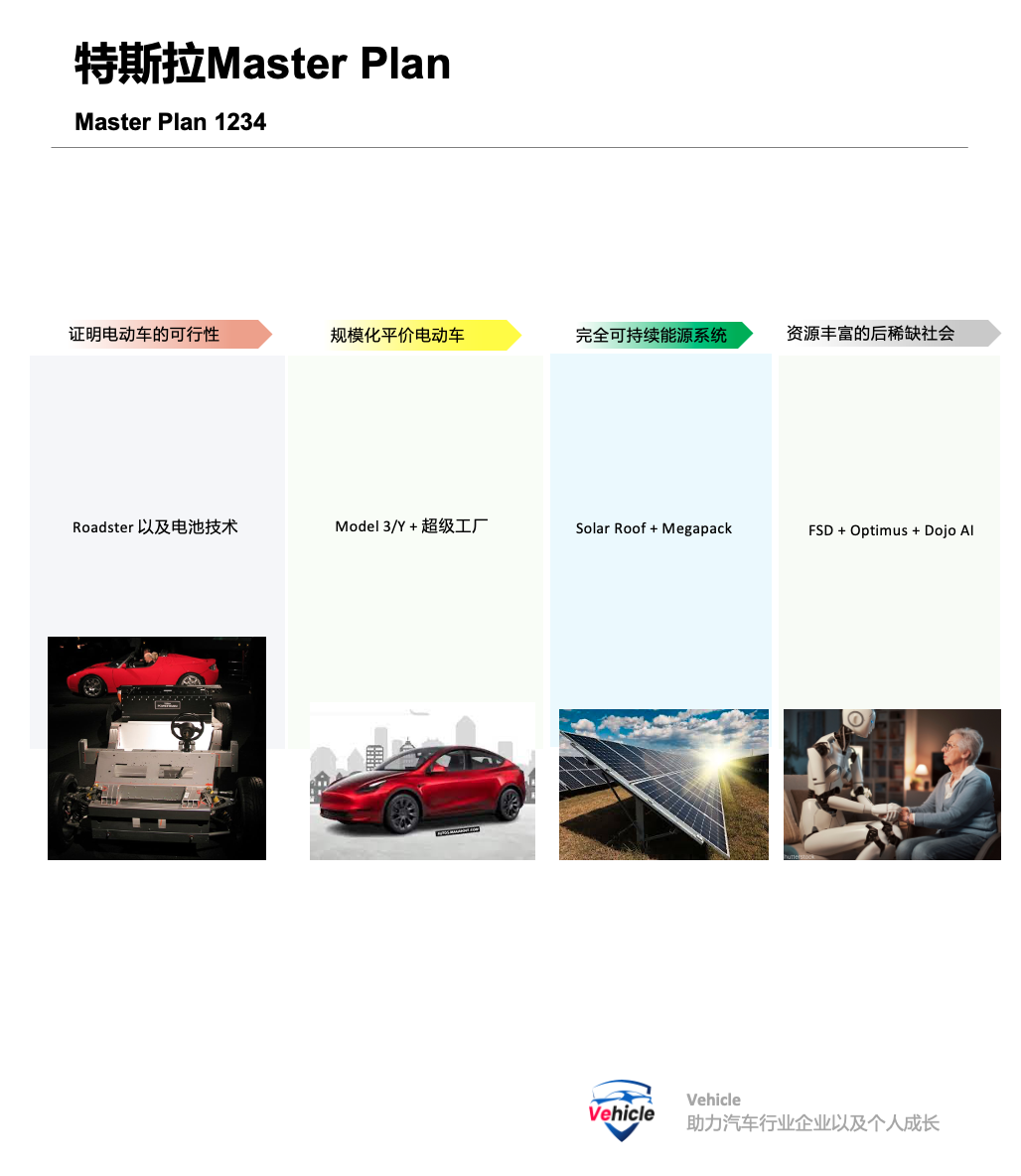
V. Implementation Paths and Challenges. People are not easily deceived. How will Musk realize this dream? Musk's answer is to continuously drive development through the success of Tesla's Model Y and FSD and transfer relevant technologies and experiences to the robotics industry. Therefore, the main key paths to realizing Master Plan Phase 4 are:
Technological Synergy: Migrating automotive AI algorithms to robots and reusing battery technology in energy storage systems.
Manufacturing Revolution: As we previously introduced in a video, Tesla's Model 2, the next-generation vehicle, will redefine automotive manufacturing, making it similar to consumer electronics production lines. Tesla plans to produce cars on a super-fast production line at a rate of 5 seconds per vehicle, knowing that the current rate is approximately 60 seconds, representing a speed increase of over 10 times. This significantly promotes large die-casting technology.
Policy Breakthroughs: This is the most challenging aspect. Musk has been committed to promoting the opening of global autonomous driving regulations, which is currently expected within the next five years.
Ultimately, Musk is Musk, and he lowers everyone's expectations, stating that although the overall trend is this way, society and life are still like a Netflix series with highs and lows. Therefore, the main risks include:
Ethical Challenges: The large-scale replacement of human labor by robots may cause social unrest.
Energy Paradox: Will the infinite resources stimulate excessive consumption?
Technological Singularity: The controllability of AI systems (establishing a "value alignment" mechanism is necessary).
VI. Conclusion
The essence of Master Plan Phase 4 is leveraging technological leverage to drive civilizational upgrades. Its ultimate goal is not simply environmental protection but to create a "cosmic-level sustainable civilization" where humans and machines coexist and humanity thrives on both Earth and in space.
Led by Musk, Tesla has transcended its role as an automotive company at this stage, becoming a cross-dimensional technology integration platform. Its success will depend on whether it can find a dynamic balance in the co-evolution of energy, AI, and robotics.
For detailed information on Tesla's 2025 Q1 All-Hands Meeting, you can click on "Tesla 2025 Q1 All-Hands Meeting: Musk's Speech Interpretation and Full Manuscript" to view the full speech manuscript. Perhaps your understanding of Musk's dream for Master Plan Phase 4 will be different.
Reproduction and excerpts are strictly prohibited without permission - References:
Musk's 2025 Q1 All-Hands Meeting speech original text and video
Join our knowledge planet to download a massive amount of first-hand information on the automotive industry, including the above references.

